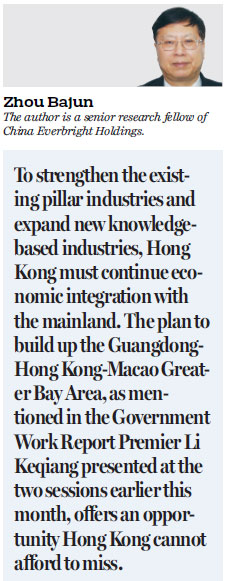A three-front approach will make up for lost time
Updated: 2017-03-22 07:30
By Zhou Bajun(HK Edition)
|
|||||||
Zhou Bajun argues that HK's prosperity rests on upgrading its industrial base, continuing economic integration with the mainland and playing an active role in Belt and Road
The Hong Kong Special Administrative Region will soon elect its fifth-term Chief Executive. The most important issue facing the government in the next five years will be economic development.
There are two related major tasks in Hong Kong's economic development: Raising the pace of transformation into a knowledge-based economy and increasing the ability to cope with cyclical fluctuations in the global economy.
The transformation into a knowledge-based economy should have started before the handover in 1997 but did not because the British colonial administration was not interested in "planting trees" for the future SAR in the last days of its rule. Following the handover, the first four terms of government have let some 20 years go by with little effort in that regard, thanks to the blind faith of our top financial officials in "positive non-interventionism".
Hong Kong has a relatively incomplete industrial structure and has relied on the Chinese mainland market too much for its own good, to the point that it invariably experienced severe fluctuations when cyclical turbulences such as the Asian financial crisis in the late 1990s and global recession caused by the US-triggered financial crisis of 2008 have occurred.

With those past experiences in mind Hong Kong needs to pick up the pace of economic transformation and strengthen its ability to handle cyclical fluctuations of the economy. To do so it should take action on three fronts simultaneously: Optimize and upgrade its industrial structure; continue to expand its economic integration with the mainland, and play a positive role in implementing the Belt and Road (B&R) Initiative.
Optimizing and upgrading Hong Kong's industrial structure requires action in two areas. One is to develop knowledge-driven new industries and reduce the GDP and job market's over-dependence on the real estate sector; the other is to guide and assist small and medium-sized enterprises (SMEs) in pursuing friendly mergers and acquisitions to become larger companies and gradually lower the super-high percentage (over 98 percent) of SMEs in the local corporate structure.
Hong Kong cannot optimize and upgrade its industrial structure behind closed doors. If it does it will be impossible to avoid the hostile takeover of smaller firms by bigger ones with undesirable consequences. Currently most of Hong Kong's pillar industries are already going downhill or showing signs of deterioration, with the exception of the financial industry.
One of the main reasons for this is that mainland-based competitors have grown stronger. For example, the port service sector in Guangdong and especially Shenzhen is so well developed that mainland-based manufacturers no longer rely on Hong Kong for overseas shipping. The financial industry has remained prosperous in recent years mainly because the mainland's financial sector has not become as developed and open as Hong Kong's and still depends on the SAR in many ways. However, if the economic integration of Hong Kong and the mainland does not progress further in coming years the mainland financial industry's dependence on Hong Kong's expertise in international financial services will surely dwindle and eventually disappear for good.
To strengthen the existing pillar industries and expand new knowledge-based industries, Hong Kong must continue economic integration with the mainland. The plan to build up the Guangdong-Hong Kong-Macao Greater Bay Area, as mentioned in the Government Work Report Premier Li Keqiang presented at the two sessions earlier this month, offers an opportunity Hong Kong cannot afford to miss.
Unlike the other three leading bay areas in the world (New York, Los Angeles-San Francisco and Tokyo) the Greater Bay Area has to overcome or work around physical and ideological boundaries between the mainland and two SARs.
The Macao government is positive about closer cooperation with Guangdong; but the Hong Kong government struggles to overcome these boundaries. The truth is Macao and the nine major Pearl River Delta cities of Guangzhou, Shenzhen, Zhuhai, Foshan, Zhongshan, Dongguan, Huizhou, Jiangmen and Zhaoqing in Guangdong can build a greater bay area without Hong Kong but the result would probably not be as impressive as otherwise. Meanwhile Hong Kong will soon find itself left behind by some of its mainland neighbors. Shenzhen, for instance, is already breathing down Hong Kong's neck in terms of annual total economic value in addition to having a more rounded industrial structure and much better developed innovation and high-tech industry. If Hong Kong manages to overcome these boundaries it can easily take the leading position in the Greater Bay Area. If not it can only sulk alone over what could have been.
The country's Greater Bay Area plan is an integral part of the B&R Initiative. In the next five years Hong Kong must play a positive role in the Greater Bay Area plan as well as the B&R Initiative. To do so the city must overcome these boundaries. Hong Kong takes great pride in its rich experience in doing business with Western countries but not necessarily the 65 countries along the B&R routes. This means its role in the B&R Initiative will more likely be a partner of the mainland than a "super connector" between the mainland and other countries.
If Hong Kong manages to do well on these three fronts in the next five years it will no doubt inject new vitality into the economy. It will also take the implementation of "One Country, Two Systems" to new heights.
(HK Edition 03/22/2017 page8)